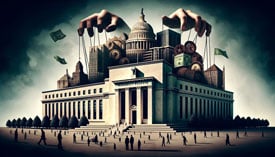Confidence in institutions such as the Federal Reserve may be falling, but it hasn’t fallen nearly as far or as fast as it should. Trillions of dollars, yen, euros, and yuan are invested according to central bank policy and propaganda. It isn’t going well.
 The U.S. economy is massively distorted, unhealthy, and hopelessly dependent on Fed stimulus. The Finance, Insurance, and Real Estate (FIRE) sectors of the economy have been overwhelming beneficiaries during the modern age of activist central banking.
The U.S. economy is massively distorted, unhealthy, and hopelessly dependent on Fed stimulus. The Finance, Insurance, and Real Estate (FIRE) sectors of the economy have been overwhelming beneficiaries during the modern age of activist central banking.
Those sectors have collectively doubled in size since 1947 as a percentage of gross domestic product, and they now account for just under 21% of the economy. More than one out of every 5 dollars is generated by banks, brokerages, insurers, and realtors – people who produce nothing tangible.
Manufacturing has fallen from 25.6% of GDP in 1947 to just 10.3% in 2023.
Meanwhile, government spending as a percentage of GDP has gone up nearly tenfold since the late 1920’s and the dawning of the big government era, during the Great Depression.
All of this central planning has done wonders for growth in the government sector and for the FIRE economy. The wealthy, with connections to government and Wall Street, have grown wealthier.
But it has been a disaster for most Americans. During this period American households have shifted from needing one income to two incomes.
Housing is completely unaffordable for most Americans. Household debt has risen dramatically, along with every taxpayer’s portion of the public sector debt.
Many Americans seem to be checking out. The rate of employment – the percentage of working age people actually working – is in steady decline and more people are dependent on government assistance.
The worse news is that average Americans will likely still wind up holding the bag for all of the economic and monetary mismanagement.
Financial assets are largely disconnected from economic fundamentals. They are dependent instead on Fed policy.
Last week’s rally in stock prices, based upon surprisingly weak jobs data, is an example. It might have been bad news for businesses and job seekers, but money managers and trading algorithms ignored that and focused on rising odds of interest rate cuts.
Central planners at the Fed have cultivated massive bubbles in stocks and real estate.
Today, much of their efforts are on keeping these bubbles inflated. Which means the U.S. economy, and others, are one or two policy errors away from disaster. If history repeats, it will be Wall Street and the well-connected who receive bailouts, not average Americans.
The trouble is these errors may not be visible except for in hindsight.
Fed officials assured us the U.S. economy was strong and that housing was not in a bubble immediately prior to the 2008 financial collapse. The Japanese economy has languished for decades. Central bankers there have tried one stimulus program after the next for more than 30 years, without success.
Now the yen has collapsed to its lowest levels versus the U.S. dollar since 1990, when the malaise set in.
Anyone who thinks the central planners in the U.S. (or Europe or China) are smarter and more capable than those in Japan are kidding themselves.
American investors who might be counting the FOMC and economic policy advisors in Washington DC to safeguard the U.S. economy should watch this incredible clip and reevaluate.
********



